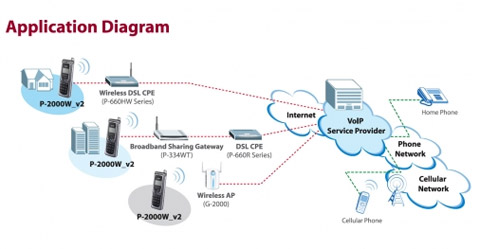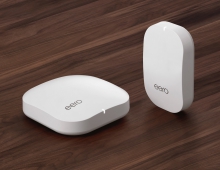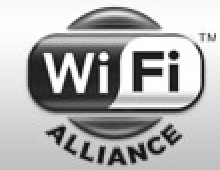The ZyXEL P-2000W V2 VoIP WiFi Phone
2. Design and Setup
Specifications
Wireless- IEEE 802.11b support
- Frequency band: 2.400 ~ 2.4835GHz
- Channel: FCC Ch1~11, ETSI Ch1~13, Japan Ch1~14
- Data rate: 11 / 5.5 / 2 / 1 Mbps
- Output power: 17.06 dBm
- Sensitivity: -82 dBm@11Mbps
- Operating range: Out-door up to 300m, In-door up to 75m
- 64/128 bit WEP encryption
- Support site survey and wireless profile
- Support open standard SIP v2 (RFC3261)
- SDP (RFC2327)
- RTP (RFC1889)
- RTCP (RFC1890)
- CODEC support: G711, G.729a
- G.168 echo cancellation
- Silence suppression
- Voice Activity Detection (VAD)
- Comfort Noise Generation (CNG)
- Message Waiting Indicator
- Built-in phone book
- QoS support TOS / DiffServ
- Standby time 13~24 hour (Depend on wireless environment)
- Talk time 3.2~4 hour
- Outbound proxy
- STUN (RFC 3489)
- Manual configured WAN and SIP address
- IP address assignment: Fixed IP, DHCP client, PPPoE
- HTTP, TFTP, TCP, UDP, DNS, ARP, ICMP
- LCD screen displayed menu and keypad settings
- Built-in Web Configurator
- Support secured HTTP Auto-Provisioning
- Dimensions: 127 (W) x 45.7 (D) x 20 (H) mm
- Weight: 105g
- Notification: Ringer, Vibration
- Display: Mono-LCD, 112X 64 dots
- Buttons: 0~9, *, #, 11 functional keys
- Port: One ear-phone jack, one USB-type connector for charger
- Battery: 3.7V, 1350mAh
- Temperature: 0°C-40°C
- Humidity: 20% - 85% (non-condensing)
- Available 802.11b or 802.11g access point
- High-speed Internet connectivity
- A CD-ROM drive
- Windows 98SE, ME, 2000, or XP
Design
The ZyXEL looks like an older generation cell phone. The phone measures 5.4 by 1.8 by 0.7 inches and weighs 3.8 ounces. It is comfortable to hold - but a little big to stash away. If your goal is to use a WiFi phone in your home - then the size really doesn’t matter that much.
The phone feels like it is quite sturdy - the construction is good and the feel of the buttons is satisfactory. The phone sports a monochrome screen which gives the user all the data needed. In today’s world of nice, colorful screens - it is a little amazing to me that ZyXEL chose to go with an old fashioned monochrome screen.
There are the traditional Green send and red end buttons, a modified D-pad for navigation and two sort of "soft keys" below the screen. One brings us the menu and the other lets you scroll through stored contacts.
Setup
Let’s just say that setup is incredibly complicated. The Instruction manual is very detailed about how you first turn the phone on, do a site survey, search for access points and then attempt to connect.
If that works - you are in business. If not, the procedure is very technical and frustrating and will most likely necessitate a call to technical support.
These paragraphs come from the ZyXEL web page and attempt to explain the benefits of this kind of setup and the options it allows the user. If you can make heads or tails out of what this means - then you are more technically savvy than I and will most likely not have any problem with setup issues.
The call control protocol of the P-2000W is based on SIP v2 (Session Initiation Protocol version 2, RFC 3261) open standard, which is interoperable with major SIP-based call servers, IP-PBXs, and other standard SIP-based client devices. The P-2000W_v2 is compliant with the IEEE 802.11b standard and interoperates with any existing 802.11b or 802.11g wireless AP and gateway. It may be used as a cordless handset for residential users or for business users in an office environment. The small form factor of the handset is easy to transport and allows users to place VoIP phone calls in public 802.11-based environment.
The P-2000W_v2 is capable of tagging features that support a service provider's QoS (Quality of Service) planning, such as ToS (Type of Service). It allows gateways or central side equipment to identify and prioritize voice and data traffic. By supporting G.711 and G.729 voice compression technology, the P-2000W_v2 effectively reduces bandwidth consumption caused by voice traffic.

Ease of Use
Once the ZyXEL is set up, it was actually quite easy to use. A simple turning on of the phone and it obtained my IP address, connected to my router and I was ready to go.
Calling is as easy as dialing the number. The cool thing about this phone is that it works like an actual phone…. you know what I mean. It makes calls, receives calls and stores numbers like a typical home phone handset - but it is all done over a WiFi connection.
Call Quality
This was a mixed bag with the ZyXEL. Sometimes, I heard an echo on my end. Sometimes, people on the other end said I sounded “far away.” Other times, call quality was clear and loud.
I did have some issues with drop outs every so often. Instead of a complete disconnect - I found that my caller was still on the other end and I needed to repeat what I had said.
Options
When hitting the “menu” button, a list of sub menus (each with separate options) is displayed - these were:
- information
- call history
- phonebook
- net settings
- SIP settings
- settings
- wireless
- and restart
I found than unless the user has trouble with the connection - it is best to stay away from most of the sub menus. Just let the thing do its job as a phone.
Battery Life
Along with the complicated set-up issues, this was the achilies heel of this phone. Battery life was a paltry two hours MAX - whether I was using the phone or not. This meant that for all practical purposes, the phone needed to be plugged in when not in use. This is not a big deal if you use it as a WiFi phone in your home - but if you are a mobile traveler trying to use this in HotSpots - I would imagine the short battery life would be a problem.





















